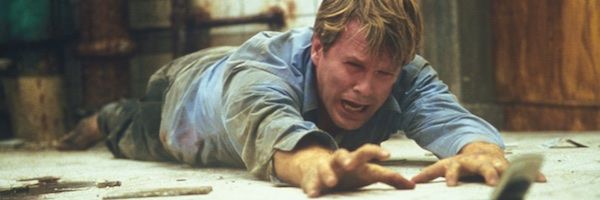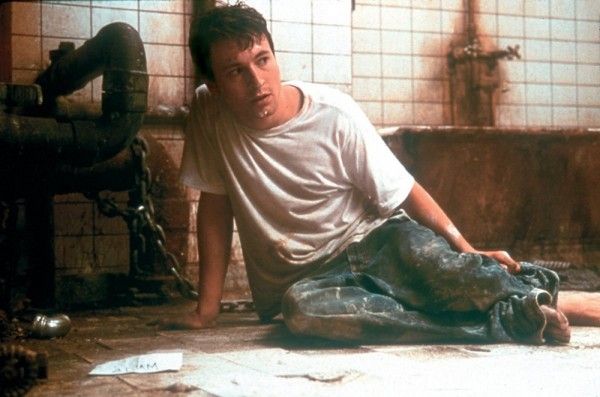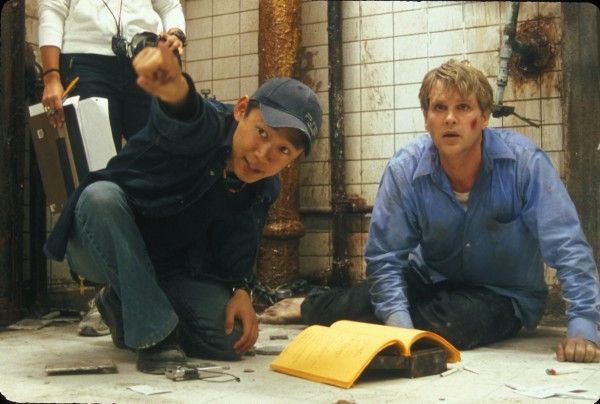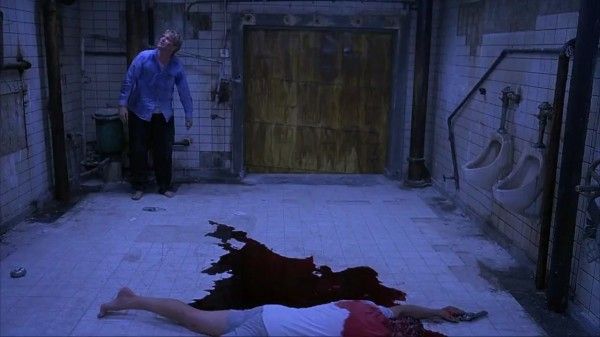Last week I trekked down to Lionsgate to celebrate the 10th anniversary of Saw with director James Wan and its writer/star Leigh Whannell along with some of the film's cast. After the event I sat down for an interview with the pair that proved to be a great chance to get their perspective not only on the film itself, but the sequels and legacy that followed it. Many people forget how innovative the original Saw was, choosing to skip over the fact that it's basically a thriller in their rush to label it "torture porn."
We spoke about that label, Whannell's upcoming directorial debut Insidious: Chapter 3 and the challenges Wan faced bringing in his biggest film to date, Furious 7. We lightly touch on The Conjuring and I feel a little bit of regret for not pushing harder against the clock telling us we were out of time, since it was only days later that Wan was announced as the director for The Conjuring 2. But it's definitely worth a read regardless since these two guys are very smart and have changed the horror landscape time and time again. If you've never seen Saw, be sure to check it out in theaters on October 31st (it actually starts showing at 8PM on October 30th). And if you've already seen the film, this is a brand new transfer that makes it a new experience all over again. Hit the jump for the interview.
How does it feel revisiting this movie 10 years out?
LEIGH WHANNELL: I remember reading an interview with George Lucas and he said that he doesn’t like revisiting Star Wars because the only things he sees are the mistakes, he doesn’t see the stuff that people love. He just sees the door in the background that didn’t quite work that day. It’s sort of the curse of the filmmaker. And as James said, there are a lot of things in Saw that were thrown together. It was a cheap film, and that was the point - to make a cheap film. But it’s hard for us now to watch it, though at least we’re laughing about the mistakes. And the success of the film has given us license to do that.
If it had made $200,000 it would be a different story.
WHANNELL: Yeah, yeah.
JAMES WAN: We would be so bitter!
WHANNELL: Instead of laughing we’d be pointing at it going, “God, if only we had gotten that right.” For me personally I’ll say that I constantly think about the film because it’s the only reason I’m sitting here talking to you.
It spawned this huge franchise, and when it gets to the point where you’re at the sixth or seventh installments, it has to be a little surreal.
WHANNELL: Definitely. It’s a very strange thing to have other people take something you’ve created and take it in another direction. I always compare it to having a child and raising a child and letting them go off and become their own person. It’s a strange feeling to be driving down Sunset Blvd. and see a billboard to a film that is a sequel to something you created. It all started with us and now someone else had taken over. Every Halloween it would happen, and I found it very strange.
WAN: The whole thing started in our bedroom, where I designed the doll. And the first film almost feels homemade. Which actually, to dovetail slightly, is what Leigh and I wanted when we went off to make Insidious, that homemade freedom and quality you get with Saw. There’s something very cool about that indie spirit that I try to hang on to even now with the bigger films that I’m working on.
WHANNELL: And we’re affectionate about the sequels. I think the first Elm Street movie I saw was Dream Warriors. And those teenage years, you kind of lose track. I had this one friend who was into horror who was allowed to watch these types of films. I wasn’t, so I’d go and sleep over and he’d show me a Friday the 13th movie and I’d ask which one it was and he would say, “I think it’s Part 6.” We would lose track. It didn’t even matter.
WAN: Funny you should mention that, it’s what people say about the Saw franchise too!
WHANNEL: That’s what I was going to say. When I see all of these sequels I think of all of these horror franchises that I saw growing up.
WAN: That’s what I’m hoping for. That the generation who got into the Saw films a bit later will now have the chance to revisit the first Saw movie in theaters. And one of the things I tried to do with this re-release, I went back and supervised the 4K transfer. I got to do a lot of tweaks I didn’t have the chance to do back then because we didn’t have the money or the time. I didn’t want to change it too much, I didn’t want to change the look too much. But I just wanted to fix things here and there, “that’s too dark and that’s too bright.”
WHANNELL: I popped into the room where James was color grading the film and, after not having seen it for so long, you see how charmingly low budget it is.
These films occasionally get a bad rep as “torture porn” when a lot of them aren’t even that mean spirited.
WHANNELL: Especially the first one. It’s a thriller. It’s two guys desperate to get out of this room and every now and then we cut outside the room to show you what this bad guy is up to.
WAN: It’s really interesting. Brian Collins and I had this conversation recently where the movie in some places plays like a drama. The characters sit around and they actually chat. And Brian pointed out to me that, compared to the sequels, it’s a very minimal film. And it actually is. When I go back to it, it’s so minimal.
WHANNELL: The fact that Saw is called “torture porn” is something… I think the film got that label from the sequels as they got more and more gory.
The first one is more about the idea.
WAN: Watching it again, it’s not gory at all. There are barely any scenes with gore because we couldn’t afford it.
WHALE: It’s hard for me to have any annoyance when thinking about the word “torture porn.” When I think of it, I think about our movie and our dreams coming true.
WAN: And the fact that we have other things to show what we're capable of makes me okay with it.
That's true. The Insidious and Conjuring franchises are largely bloodless.
WHANNELL: That's true. And I think that "torture porn" is a phrase that the mainstream press glommed onto. But you know from having worked in the genre for so long that these kind of gory, intense movies have been around for so long. They were just never successful in the mainstream like this one was.
Leigh, you're in post on Insidious: Chapter 3 right now. When I was on set I was very impressed with what I saw. It looked "big" to me.
WHANNELL: Cool. I really hope so. It was my first time directing, but watching James direct over the years is the best film school for horror directors that you could go to. I feel like I probably absorbed more than I thought I did, like Ralph Macchio in The Karate Kid it wasn't just about painting the fence.
WAN: [laughs]
WHANNELL: And then I got on set and was answering these questions. I had no idea what I was doing. James was off doing Fast & Furious and Jason Blum was like, "James is busy, do you want to direct it?" And like anything in life, sometimes the opportunity is there before you think you're ready for it. It's like having a child, you just learn as you go. I wasn't sure I wanted to direct "Part 3" of anything. But then I went into a movie theater in LA and it kind of brought me out of the fog. A lot of people say going to the movies is dead, but to this day just the smell of popcorn in the lobby makes me happy. So I'm standing there thinking, "wow. Hardly anything gets released in theaters anymore." It's either The Avengers or one of these Blumhouse movies.
WAN: So many movies get made and so many go to VOD, which is a market I admire.
WHANNELL: iTunes is now your local independent theater.
WAN: Exactly. But to get a chance to do something that gets in front of a lot of people is a big deal. And when I went to set to visit Leigh, it was amazing. It was like watching a guy who had directed many movies before. I was envious of how relaxed he seemed on set! And to see how creative he is with the set pieces too.
And James you went from a $1.5 Million budget on Insidious to $10 Million with The Conjuring to something much higher on Furious 7. How was it acclimating to that and how is it coming together now?
WAN: The size of the budget doesn’t make that much of a difference because the kind of issues I have on a low budget film I I have on a big budget film as well, but they’re just much bigger. It doesn’t matter how big or small your film is, you still don’t have enough money. You don’t have enough time to shoot it. When you’re making a bigger movie you have much bigger set pieces that require more time and more effort and more people. But Fast 7 is definitely the hardest movie I’ve had to do in my career. And it’s not just me. Neil Moritz [the film’s producer] has been doing this for a long time and is a very successful, seasoned producer and he said that to me too. That Fast 7 is the hardest movie he’s ever had to make as well in his entire career. And it’s very true. But I think the final product will surprise a lot of people. It’s that hardest film I’ve ever had to make but it’s also the one I’m proudest of. I’m really proud of this film.




